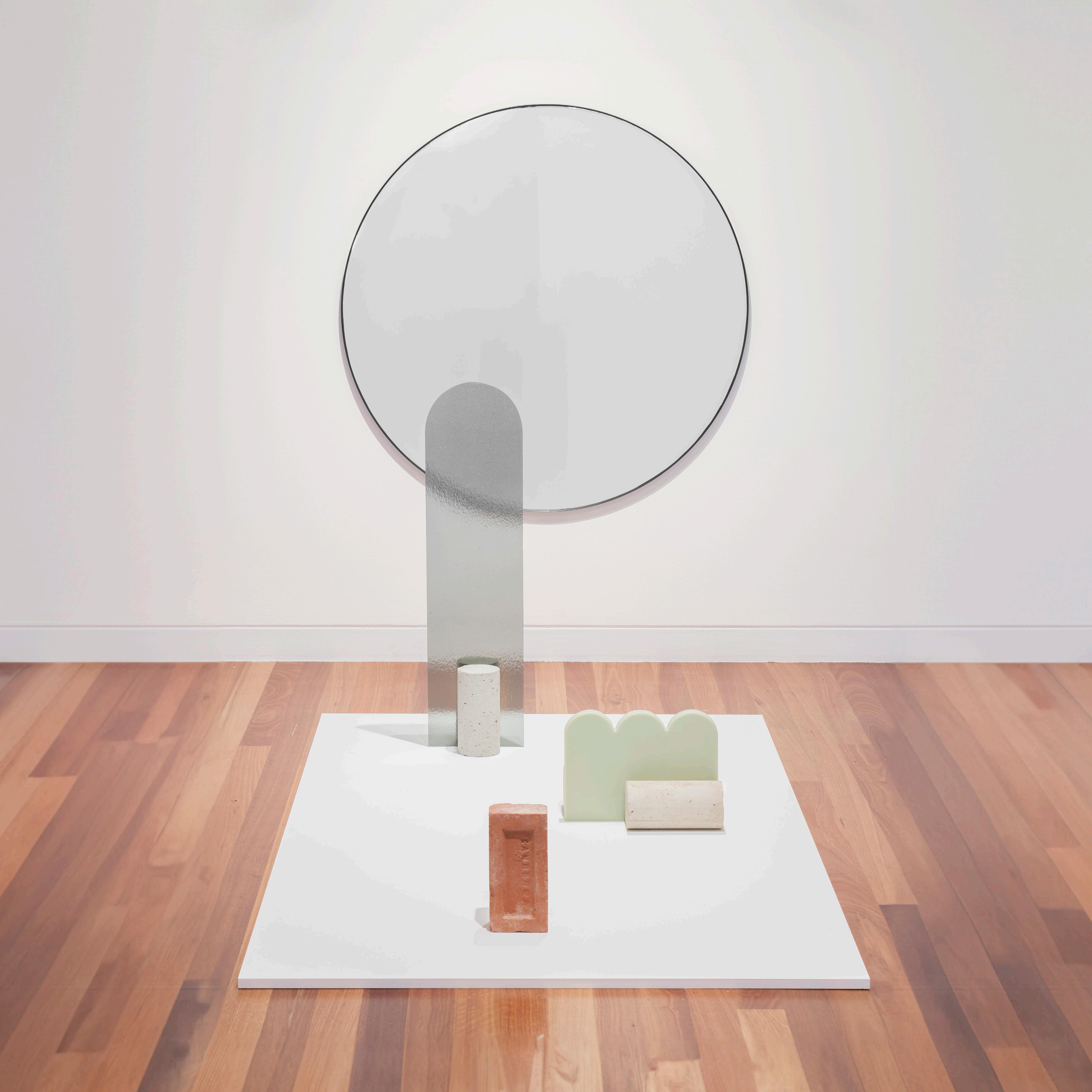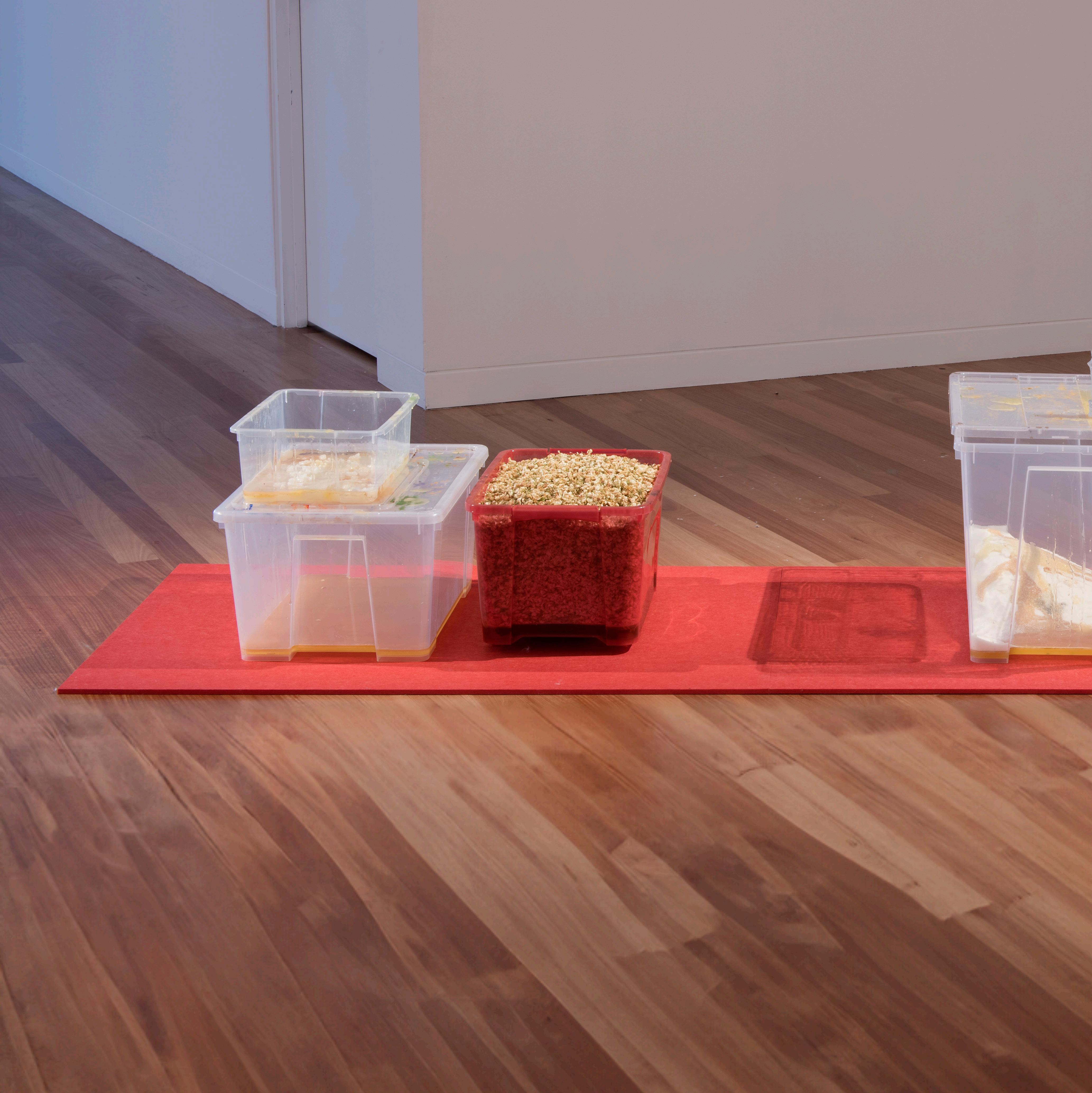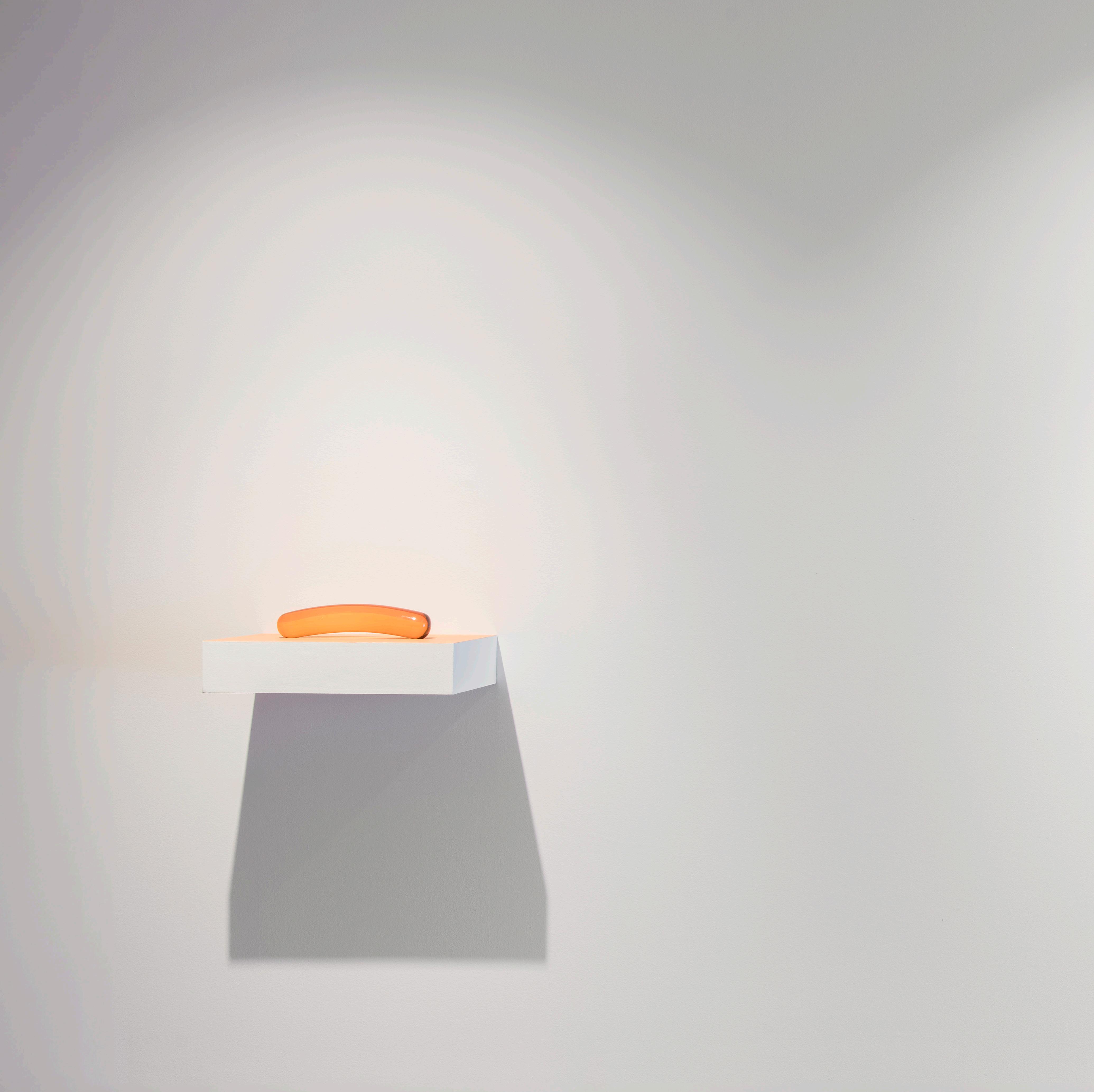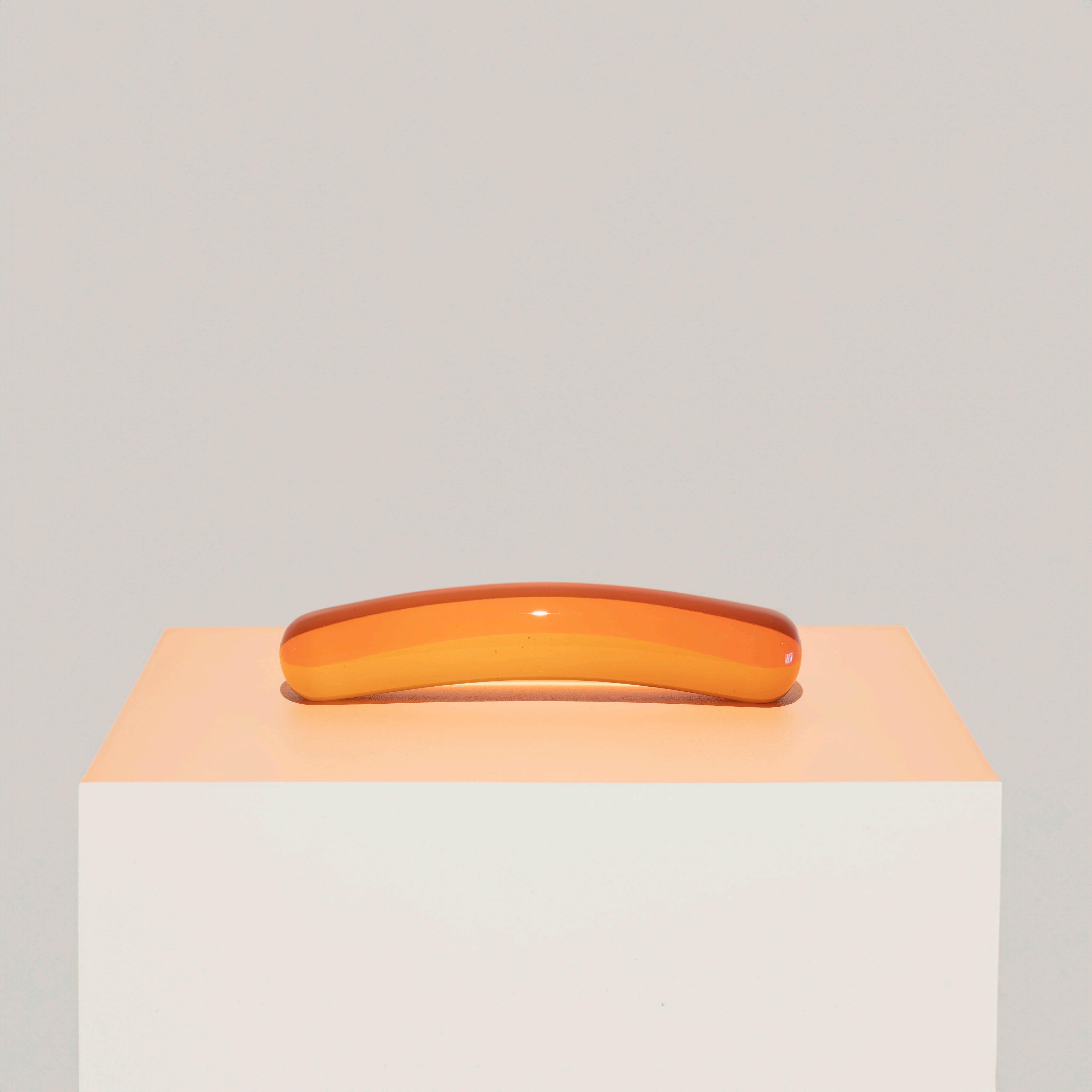The taste of lilac
Body, doorway that you are, be more than what I’ll pass through. -
Ocean Vuong1
You never reach the Body without Organs, you can’t reach it, you are forever attaining it, it is a limit. -
Gilles Deleuze2
Emma Beer and I greet each other in the car park under a street lamp at night. While we walk towards her studio I watch her dog Trevor cock his leg and piss on a nearby bush. Under the artificial lighting the urine droplets glisten on the dark green foliage and at that moment I think it is such a beautiful sight to witness. She isn’t aware that the concept for this exhibition came out of ongoing conversations in and around her studio.3 Ambling talks between Emma and myself, or the two of us with Bryan Foong. Here we speak about everything; the mundane everyday, the meaning of materiality in art, we ruminate on lovers past and present, and kick around our opinions on the idea of a ‘queer aesthetic’ or if formalism really means anything anymore.
Inside the cold studio we look at Emma’s recent paintings. I show interest by immediately pointing at a strange painting in the nearest corner resting on the floor. “Oh! you weren’t meant to see that” she says and quickly tucks it away out of sight. Emma and I talk in our now familiar shorthand about the development of her work. I point out tiny brushstroke details and we natter about how the paint seductively pools at the limit of the canvas’ edge. The lines are freer than before and I fixate on a colour which is similar to a battery acid green. Instantly, it throws up a memory which I can feel stirring inside my mouth - I am forever haunted by my feelings in front of Emma’s paintings. My tongue tingles with the recollection of being a bored ten year old child. I am sitting cross legged on the living room carpet licking the ends of a 9 volt battery, just for the thrill of it. I am laughing by myself with a curious and strange delight. The sensation fades from my body.
Image LOTTE FRANCES
Moments That We Can’t Leave Behind, 2023
Oil, acrylic, oil pastel on canvas, 90 x 70cm
1 Ocean Vuong, Time is a Mother (New York: Penguin Press, 2022)
2 Gilles Deleuze and Félix Guattari, Thousand Plateaus: Capitalism and Schizophrenia (Minneapolis: University of Minnesota Press, 1984)
3 The initial concept for this exhibition came out of ongoing conversations with Emma Beer throughout the development of the essay “Different Dream, Same Colour Blue” which I wrote for her survey exhibition Emma Beer: Zooper Dooper, curated by Tony Oates (Canberra: ANU Drill Hall Gallery, 10 February - 10 April 2022)
Photo by Brenton McGeachie

 Image KATE BOHUNNIS (left) EMMA BEER (right)
Image KATE BOHUNNIS (left) EMMA BEER (right)

Emma and I make a final selection of paintings and I can feel my shoulders start to tighten. I make a gesture with my arm as though I am pushing back an invisible obstacle. With a nervous energy, I begin to speak with speed at Emma about my apprehensions of curating an exhibition about queerness - of being seen. The subject matter of this exhibition is personal to me. To bring myself - authentically and with intention - into my writing and curatorial practice requires a certain level of vulnerability. Working in the historical traditions of abstraction could only take me so far; Bodies without Organs is about materiality, the body - my body, our bodies - and feelings. I chuckle awkwardly and change the subject with the same haste. “You know what’s funny, it wasn’t intentional but there’s this lilac colour in a lot of the works for this show. Louis and Lotte use it too”. Emma gasps “Lilac Wine, do you know that cover by….”. I’m only half paying attention to our conversation that follows. I am staring at the lilac paint with focus and hearing the sound of Nina Simone.
I made wine from the lilac tree
Put my heart in its recipe
It makes me see what I want to see
And be what I want to be4
Lilac is a significant colour. A pale and softer shade of purple it is neither red or blue. It is the warmer middle ground between the two opposing conditions of ‘cold’ and ‘hot’. As a substance, lilac creates both a tangible and metaphorical opening to experience the spectrum of variability connecting these two states. Similar to Nina Simone’s rendition of ‘Lilac Wine’ it soothes a constant anxiety within my body. To see and feel the self reflected illuminates the nuances of my own desires and the potential for becoming.
So what is this BwO? - But you’re already on it …… on it we sleep, live our waking lives, fight - fight and are fought - seek our place, experience untold happiness and fabulous defeats; on it we penetrate and are penetrated; on it we love.5
Image LOUIS GRANT
Make
4 ‘Lilac Wine’ was written by James Shelton in 1949. It was first performed in 1950 and was recorded as a single in 1952 by Eartha Kitt. Notable versions of ‘Lilac Wine’ include Nina Simone (1966), Jeff Buckley (1994) and Miley Cyrus (2012).
5 Deleuze and Guattari, Thousand Plateaus: Capitalism and Schizophrenia, 150
me fall where I stand, 2023, Cold worked mirror, kiln formed and cold worked glass, cement, Canberra red brick, dimensions variable
Photo by Brenton McGeachie
Preliminary study of deranged metabolism, for example, in relation to the paternal body 2023
Vegetable oil and oil mediums, epoxy resin, white sugar, sugarcane mulch, glycerine, lactic acid, acetone, paraffin wax, water, desiccated jasmine flowers, pigment, acrylic, acrylic mediums, porcelain statues of Goddess of Mercy, Mandarin pits, plastic containers, acoustic pinboards, 360 x 80cm
 Image BRYAN FOONG
Image BRYAN FOONG


A healthy distance (parts 1 and 2), 2021-2022
Stainless steel, faux fur, beads, faux pearls rope, cotton
Dimensions variable
 Image KATE BOHUNNIS
Photo by Brenton McGeachie
Image KATE BOHUNNIS
Photo by Brenton McGeachie

Bodies without Organs is a group exhibition that explores the relationship between queerness, gender and materiality. It features works of art by Emma Beer (she/her), Kate Bohunnis (she/her), Bryan Foong (he/they), Lotte Frances (they/them), Louise Grant (he/him), Annie Parnell (she/her) and with a performance by Angus McGrath (he/him). It is as much about their specific art practices, as it is about my relationship to their works of art and to them as individuals. This exhibition is about interconnections. It is about what I see, feel and think when I encounter their paintings and sculptures and how we - artist and curator - discuss their meaning through our individual or shared experiences of understanding the body, materiality and queerness. The structure of that statement is significant because Bodies without Organs has been developed through feeling - our feelings - and is further supported by thinking.
The French philosopher Gilles Deleuze wrote that feeling or what can also be referred to as ‘sensation’ is the result of ‘Being-in-the-World, as the phenomenologists say: at one and the same time I become in the sensation and something happens through the sensation, one through the other, one in the other’.6 Deleuze’s complex statement refers to the work of another French philosopher, Maurice Merleau-Ponty and his earlier writings on the entangled relationship between perception, being, and the world of objects that surround us. Merleau-Ponty writes that ‘what remains to be understood precisely is the way the world comes to belong to the subject and the subject to [themself]… our hold on things and on our states of consciousness’.7
My interest in their writing, more specifically Deleuze (from whom the title of the exhibition is drawn) is concerned with exploring the sensations that arise within ourselves - what he refers to as a type of organised ‘organism’ - in response to materiality, colour and form. Where do these feelings begin, is it in the mouth, hands, ears, stomach or crotch? How far do they spread throughout our body and at what frequency or level? How do we describe or make sense of them in relation to the self? The answer is not the key to this exhibition, because it is the tantilising process of becoming that this project Bodies without Organs seeks to make apparent.
The body without organs is opposed less to organs than to the organisation of organs we call an organism. It is an intense and intensive body. It is transversed by a wave that traces waves or thresholds in the body according to the variation of amplitude.8
6 Gilles Deleuze, Francis Bacon: The Logic of Sensation, trans. Daniel W. Smith (Minneapolis: University of Minnesota Press, 2002): 31
7 Thomas Baldwin ed, ‘Phenomenology of Perception’ in Maurice Merleau-Ponty: Basic Writings. (London and New York: Routledge, 2004): 172
8 Deleuze, Francis Bacon, 44-49
Image ANNIE PARNELL Tutti fruitt monument, 2022
Porcelain, glaze, ceramic stain, 12 x 12.5 x 11cm
Photo by Brenton McGeachie

From birth, we are taught to ascribe language to our bodies - how our internal components are interconnected, their functions, their value and everything else that makes up our physical relationship to ‘being-in-the-world’. We are made aware of and ideate ourselves through this language-based system of categorisation and the socialised hierarchies of meaning and value attributed to them. Each of the artists included in this exhibition intentionally destabilise these coded systems that govern how we articulate the self. For example, notions of masculinity and femininity are juxtaposed, veiled or made fluid through works of art that challenge binary notions of materiality and representations of gender. In each of their practices, the artists in Bodies without Organs embed themselves and their relationship to ‘being-in-the-world’ throughout the creative process. In essence, their chosen materials are re-materialised through this act of embodiment. They each have their sights on the unknown limit - the organised organism exploded - the desire to obtain a type of body without organs. A desire to change our perception of being in the world.
June 2023
Anja Loughhead
Image ANGUS McGRATH Eternal Strobing Death (performance still), 10’00’’ duration, 8 July 2023
Photo by Hilary Wardhaugh
 Left LOUIS GRANT
Bet you wanna love me now, 2023, Hot sculpted and cold worked glass
Photo by Brenton McGeachie
Left LOUIS GRANT
Bet you wanna love me now, 2023, Hot sculpted and cold worked glass
Photo by Brenton McGeachie
 Middle EMMA BEER Break my soul, 2023 Acrylic on canvas, 70 x 60cm
Photo by Brenton McGeachie
Right EMMA BEER Blow your radiator, 2023 Acrylic on canvas 100 x 80cm
Photo by Brenton McGeachie
Middle EMMA BEER Break my soul, 2023 Acrylic on canvas, 70 x 60cm
Photo by Brenton McGeachie
Right EMMA BEER Blow your radiator, 2023 Acrylic on canvas 100 x 80cm
Photo by Brenton McGeachie
Image ANNIE PARNELL
Bodies Without Organs exhibition documentation, 2023 Porcelain, glaze, ceramic stain, dimension variable
 Photo by Brenton McGeachie
Photo by Brenton McGeachie

Image LOTTE FRANCES
 Bodies Without Organs exhibition documentation, 2023 Oil, acrylic, oil pastel on canvas, dimension variable
Photo by Brenton McGeachie
Bodies Without Organs exhibition documentation, 2023 Oil, acrylic, oil pastel on canvas, dimension variable
Photo by Brenton McGeachie


 Image Bodies Without Organs exhibition install, 2023
Photo by Brenton McGeachie
Image Bodies Without Organs exhibition install, 2023
Photo by Brenton McGeachie




 Image KATE BOHUNNIS (left) EMMA BEER (right)
Image KATE BOHUNNIS (left) EMMA BEER (right)

 Image BRYAN FOONG
Image BRYAN FOONG


 Image KATE BOHUNNIS
Photo by Brenton McGeachie
Image KATE BOHUNNIS
Photo by Brenton McGeachie


 Left LOUIS GRANT
Bet you wanna love me now, 2023, Hot sculpted and cold worked glass
Photo by Brenton McGeachie
Left LOUIS GRANT
Bet you wanna love me now, 2023, Hot sculpted and cold worked glass
Photo by Brenton McGeachie
 Middle EMMA BEER Break my soul, 2023 Acrylic on canvas, 70 x 60cm
Photo by Brenton McGeachie
Right EMMA BEER Blow your radiator, 2023 Acrylic on canvas 100 x 80cm
Photo by Brenton McGeachie
Middle EMMA BEER Break my soul, 2023 Acrylic on canvas, 70 x 60cm
Photo by Brenton McGeachie
Right EMMA BEER Blow your radiator, 2023 Acrylic on canvas 100 x 80cm
Photo by Brenton McGeachie
 Photo by Brenton McGeachie
Photo by Brenton McGeachie

 Bodies Without Organs exhibition documentation, 2023 Oil, acrylic, oil pastel on canvas, dimension variable
Photo by Brenton McGeachie
Bodies Without Organs exhibition documentation, 2023 Oil, acrylic, oil pastel on canvas, dimension variable
Photo by Brenton McGeachie


 Image Bodies Without Organs exhibition install, 2023
Photo by Brenton McGeachie
Image Bodies Without Organs exhibition install, 2023
Photo by Brenton McGeachie


